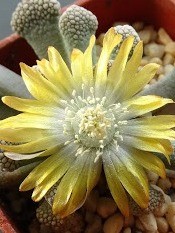White jewel plant
(Titanopsis schwantesii)

Description
Titanopsis schwantesii is a species of Magnoliopsida first described by Moritz Kurt Dinter, and given the simplified Asian name by Schwant. Titanopsis schwantesii belongs to the genus Titanopsis, and the family Aizoaceae. Titanopsis is a genus of about 10 species of succulent plants of the family Aizoaceae, indigenous to the arid regions of South Africa and Namibia. The name "Titanopsis" comes from the ancient Greek "titanos" (limestone) and "opsis" (looking like). The genus has a disjunct distribution, occurring in three separate areas of southern Africa: southern Namibia, the region around the south-eastern border of Namibia and a larger area spanning between the former Cape Province and Orange Free State in South Africa. This unusual distribution means that the different Titanopsis species live in different rainfall systems - either summer or winter rainfall depending on the species. Cultivation is easy with full sun, very well-drained soil, and attention to the natural rainfall of the particular species' habitat. The more popular species from the eastern areas, such as Titanopsis calcarea, fulleri and luederitzii are adapted to summer rainfall, while those from further west, rarer species such as Titanopsis schwantesii and hugo-schlecteri, are adapted to winter rainfall, when they also flower. The plants are calcicole (they appreciate calcareous soils), but any typical loose succulent soil mix is suitable. Division of larger clumps is possible in some cases, but as most species have tuberous rootstocks and offset slowly, seed production is the most common method of propagation.
Taxonomic tree:







